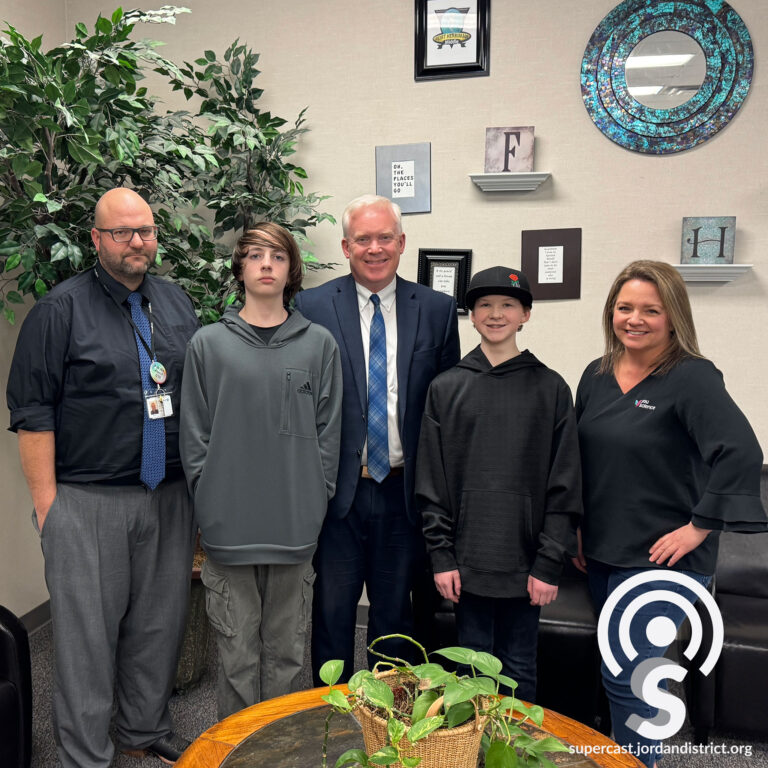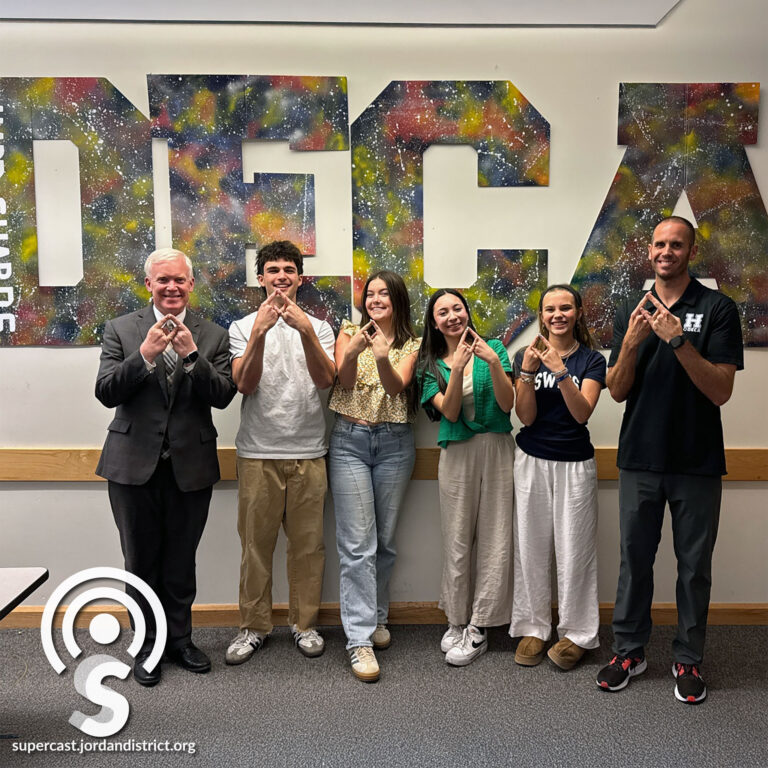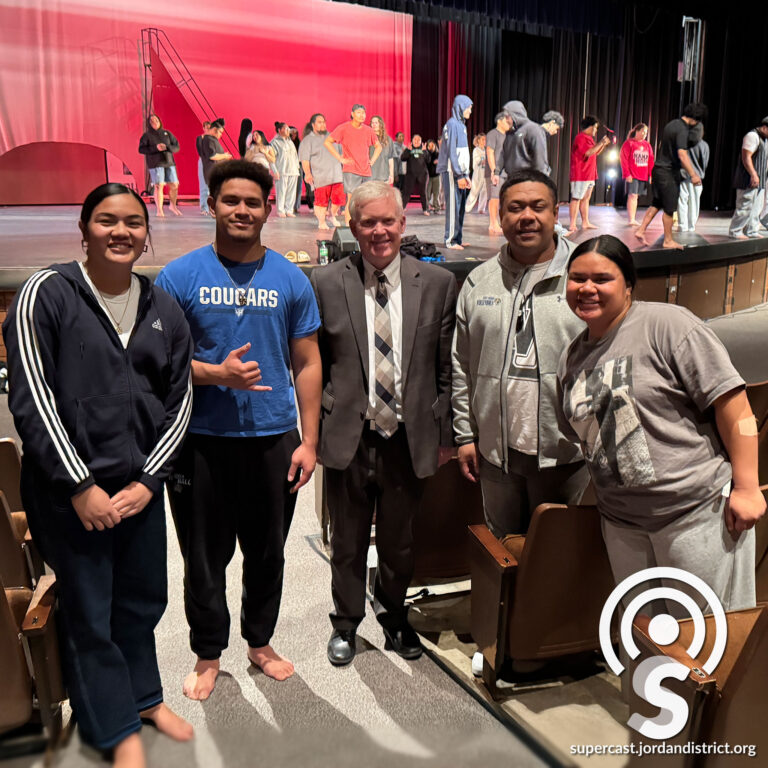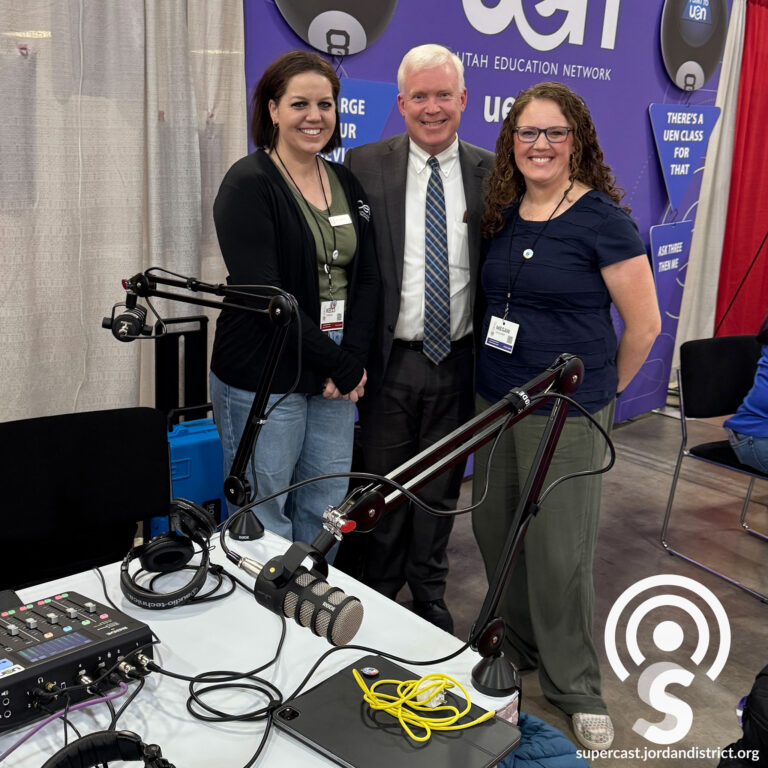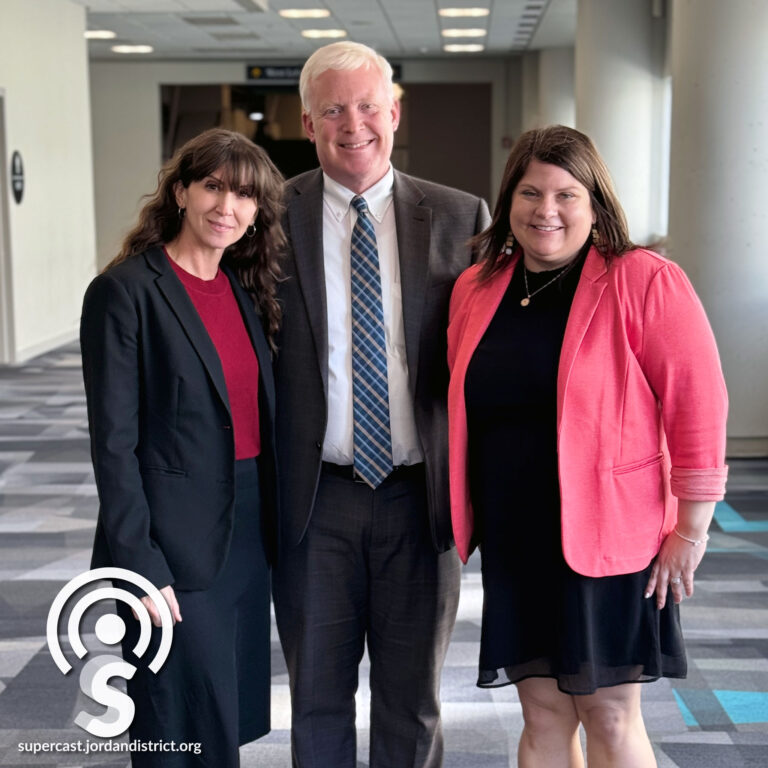What if there was a tool to help your student discover their natural ability to do something pretty amazing? Well, that tool exists and it is being used right here in Jordan School District.
On this episode of the Supercast, we meet some students involved in an aptitude-based program called YOU Science. Hear the exciting ways this program is helping students uncover natural talents they didn’t even know they had and in turn, helping them find their personalized pathways to future success.
Audio Transcription
Kellie Openshaw:
I want them to see the different exploratory classes, like maybe it tells them you're a good fit for marketing, and manufacturing, and health science.
Anthony Godfrey:
You don't always think about what industries or what jobs might be right for you, and YOU Science is exactly that. It's a scientific approach to helping connect kids with opportunities.
Anthony Godfrey:
What if there was a tool to help your student discover their natural ability to do something pretty amazing? Well, that tool exists and it's being used right here in Jordan School District.
On this episode of the Supercast, we meet some students involved in an aptitude-based program called YOU Science. Hear the exciting ways this program is helping students uncover natural talents they didn't even know they had, and in turn, helping them find their personalized pathways to future success.
We are here at Fort Herriman Middle School talking with Kellie Openshaw about YOU Science and how it's used in Jordan School District. Thanks for joining us.
Kellie Openshaw:
You're welcome. I'm glad to be here.
Anthony Godfrey:
You are the Director for YOU Science for the state of Utah, correct?
Kellie Openshaw:
That is right.
Anthony Godfrey:
So, tell us about YOU Science. What is it? And, now, the state provides that for every student in the state, and Jordan has really worked hard to take advantage of this great program. So, tell us about what it does.
Kellie Openshaw:
Absolutely. So, YOU Science is a college and career readiness platform, and it's a place where we want our students to cultivate their career and their life, and really see success for their future. So, as you mentioned, every student in Utah has access to a YOU Science account, and you know, there's a lot of college and career readiness platforms out there, and the thing that makes us unique is that we start with an aptitude assessment. We're the only company that provides an online aptitude assessment where we give the students a series of brain games and help them figure out their natural talents, like numerical reasoning, spatial visualization, 3D visualization, things like that. And so, by understanding those talents, we can show students careers that would be a good fit for them that they may not have otherwise considered.
Anthony Godfrey:
Tell us about when this is administered, when do students get access to this, and play the brain games?
Kellie Openshaw:
Sure, absolutely. So, we usually start with the aptitude assessment in seventh grade, and so we do a more simplified version. There's five brain games and then one interest survey, and we want our students, those results, to show them different industries that they're a good fit for. Because they're still in seventh grade, we want them to explore at this point, so we want them to see the different exploratory classes, like maybe it tells them you're a good fit for marketing, and manufacturing, and health science. Well, that helps them and their counselors know what kind of exploration classes to take in eighth or ninth grade to start figuring out what they may want to study more later. And then in ninth grade or after, we have them take the more advanced version, and that gets them to specific careers that they can start to discover.
Anthony Godfrey:
It's the blend of aptitude and interest. So, the brain games say, "Hey, you're pretty good at this," but then there's also interest. If you're interested in these things, these are the types of industries that might be a good career for you.
Kellie Openshaw:
Exactly. And it's really important. I mean, we obviously want our students to be interested in what they're studying. But a lot of times, if we think about teenagers and the things that they're interested in, they kind of live in this fun teenage bubble of friends and social, and sports, and music, and all the things. They haven't been exposed to a lot of the careers that are outside of that bubble. And the aptitude brings in that exposure to let them know, "Hey, I bet you didn't even know that you'd be really great at being in computers or really great at being in manufacturing.” Just things they hadn't had exposure to.
So we call that our exposure gap. When we see an interest level in an industry versus an aptitude level, the difference between the two is an exposure gap. Let's take computer science, for example. Nationwide, we pulled our data on over half a million students, and there was a 75% exposure gap from the aptitude to the interest. So, figuring out how to get through that. And here in Utah, if we look at women, that exposure gap is 92%. So, how do we help, in this case, how do we help women figure out that they could actually be very talented in computer science, but it's not something they're naturally interested in? How do we close that exposure gap?
Anthony Godfrey:
I love the way you describe this exposure gap, the idea that you're good at something, but you don't even know it's out there as a career. You don't even know it's a possibility. Utah has a very diverse economy. We’ve worked hard at that. So there are options that even parents or others who might be advising them would not be aware of.
My dad didn't say, "You know what? Have you considered being a superintendent one day? I think that would really work for you.” People can decide whether it really works for me. But I do love being a superintendent, and you don't always think about what industries or what jobs might be right for you, and YOU Science is exactly that. It's a scientific approach to helping connect kids with opportunities and with ideas about who they could be and what they could do.
So, tell me about how parents would interact with this. Parents who are listening and say, "Well, hey, I have an eighth grader. Maybe they took that last year. Maybe it kind of didn't ever hit their radar." How do parents access this information?
Kellie Openshaw:
Yeah, great question. So the first thing is to have a conversation with your student and say, "Hey, do you remember taking those brain games? Do you remember YOU Science?" Because a lot of times, the students have an account and they've forgotten.
Now, in your district, that is impossible because you're actually going back to the results often. And you're helping the students recognize this as a resource. But sometimes that's not the case. So I think the more our districts engage and go back to those results, they lean on those results to invite them to different things. It helps the parents be more engaged.
Then, when a parent asks about that and says, "Hey, show me your results," because right now they'd have to show through their student's profile. We're working on a parent profile, so we're hoping we'll have that in the next year or so. But they can then sit down with their student. They can see their talents. They can see the different careers and industries that their students would be a good fit for.
It really brings up some fun talking points for parents to have with their students, really introduces them to their students, quite honestly, where they have conversations they've never really talked about before showing, "Wow, I had no idea that you had a natural talent for organization or for recognizing patterns in numbers." Then it starts to click for the parent, where it's like, "Oh, now I know why, as a kid, you used to line up all of your race cars along the edge of the table." Or "Now I understand why you actually are really good at keeping a schedule." It just starts to help you see your students through a new light. So, for parents, I'd recommend talking to your students, have them pull up that account, and show you.
Anthony Godfrey:
Yeah, that's great. And like you said, it's a conversation starter, something that goes beyond “How was your day?” and walking through the room saying, "Oh, is that Fortnite you're playing?" Instead, it's a deeper conversation, and you learn something about your students' abilities and interests.
Kellie Openshaw:
Yeah.
Anthony Godfrey:
One of the things we did in Jordan District for those listening is we actually did go to the YOU Science results to find students who were particularly prepared or interested in the type of careers associated with NSA. We used that information, wrote letters, and sent those out to parents and students, and invited them to be part of a meeting where NSA had some internships that they wanted to fill. That was hugely successful. We had a great turnout because it wasn't just sending an email out to every student saying, "Hey, you decide whether this is of interest to you." We knew something about our students, and we were able to connect them with opportunities that they wouldn't have dreamt of.
Again, it's not like, "You know, I wonder if you would be good at the NSA internship." Once you start toward one destination, you get a little different perspective on every destination, and you can move a little closer to your ultimate goal. Each pathway, even if you don't choose to follow that for the rest of your life as a career, it informs your next choice and helps you move forward, rather than feeling around in the dark, or just doing what you figured you would do because your parents or family members were already involved.
So, I love how this blows the possibilities wide open and really does make the world their oyster in a really meaningful way. So, thank you very much, Kelly, for all the support you provide us and for taking time today.
Kellie Openshaw:
Absolutely. It's a pleasure to be here. Thank you.
Anthony Godfrey:
Stay with us when we come back more on YOU Science.
Never miss an episode of The Supercast by liking and subscribing on your favorite podcasting platform. Find transcripts for this episode and others at supercast.jordandistrict.org.
[MUSIC]Break:
Does your student want to become a veterinarian, commercial pilot, programmer? Maybe they want to make a difference as a dental assistant. These are just some of the programs offered as part of Career and Technical Education (CTE) in Jordan School District. CTE provides the technical skills needed to prepare students for future employment or a successful transition to post-secondary education. Career and Technical Education provides work-based learning opportunities. We partner with industry experts to offer apprenticeships and internships, with students working in the real world at real jobs while going to school. The CTE experience starts in our elementary schools with the Kids' Marketplace and grows through middle and high school. To explore all CTE has to offer in Jordan School District, visit cte.jordandistrict.org today, and let's get your child started on the pathway to a profession.
Anthony Godfrey:
We're talking now with Cyler and Glenn, two students here at Fort Herriman Middle School, about their experience with YOU Science. Thanks for talking with me today.
Glenn:
You're welcome.
Anthony Godfrey:
Tell me about YOU Science. What was it like taking the YOU Science assessments?
Glenn:
The number of things they were kind of weird, but they were kind of cool too, at the same time.
Anthony Godfrey:
Weird and cool number of things. What did the weird, cool number of things tell you about yourself? What did you learn in the results from YOU Science?
Glenn:
From the results, I learned that I'm great with or probably great.
Anthony Godfrey:
Allow yourself to be great. Not probably great. You are great at fill-in-the-blank.
Glenn:
Numerical checking or number checking.
Anthony Godfrey:
Okay. Did that surprise you?
Glenn:
Kind of, yeah.
Anthony Godfrey:
So you had not been walking around checking numbers, and suddenly you realize you're good at it.
Glenn:
Yeah.
Anthony Godfrey:
It's like discovering that you can fly or that you can turn invisible or something, some superpower. So, where has that led you now? Are you taking classes and doing things differently because of that?
Glenn:
Currently, I didn't think of looking at YOU Science to take my classes this year, but I am going to be taking more health science classes next year, not next year, in high school.
Anthony Godfrey:
I know this can change. You're not locked in just by being on the podcast and telling me this, but what sort of careers have you considered?
Glenn:
An EMT or a paramedic.
Anthony Godfrey:
I'm glad that there are people who want to be an EMT or a paramedic. That's exciting. What is it about those jobs that interests you?
Glenn:
I mean, you get to save people's lives.
Anthony Godfrey:
Yeah, you're definitely having an impact on people's lives in a very real and immediate way, so that's awesome. Great.
How about for you? What's your experience been? Do you remember the assessment? Do you remember taking the YOU Science assessment?
Cyler:
Yeah, I do. The thing is, for me, I didn't think it'd add up too much. I thought, “Oh, this is just something for the teacher that they want us to do. I'll just quickly do it, and then I won't have to deal with it anymore.” And then I figured out later, "Oh, I guess this does raise an impact."
Anthony Godfrey:
Sounds like you're a survivor first of all. You know how to have an assignment in front of you and take care of business right away. Tell me what changed, what shifted when you took the YOU Science assessment. How was it different from what you expected?
Cyler:
There was a lot of, I can't remember exactly, but there was a lot of random things on it like, “Oh, I don't see how this is going to help with anything. I don't understand this or that.”
Anthony Godfrey:
But it was challenging, it was engaging.
Cyler:
Yeah, it was like, “Oh, this is really weird. I don't know what to do with this.”
Anthony Godfrey:
And what can you tell me about the results of your YOU Science assessment?
Cyler:
There was one big one. I have something about spatial reasoning. I'm able to place things where it should go. I'm really good at organizing. And something it said about me was, I was really artistic.
Anthony Godfrey:
I think that's a very unique combination, that you are artistic and you're highly organized. I think that can serve you quite well. So what are some of the careers and professions, jobs that you're thinking about that could tap into your artistic and organizational sides?
Cyler:
One thing that I've been trying to do is a cloth designing. So I've been designing clothes, I have a bunch of drawings of clothes.
Anthony Godfrey:
Tell me about the designs, what sort of style of clothing are you designing? Victorian, Elizabethan, what sort of a look are you going for?
Cyler:
Honestly, I don't really have a look. It's just, I'll get like, I'll think of something like a hat or shoes or just anything. And I'll be like, “Okay, so this is what it looks like. How can I make this look special in my own way? What's something that people usually don't do?” Like, for instance, women's pants, I've heard, oh, the pockets aren't big enough, that stuff. And with pants, I'm like, “Oh, I also really want to add stripes of different colored denim in it.” So that's what I did. And I also added bigger pockets and extra cargo pockets on the legs.
Anthony Godfrey:
You have big things ahead of you, my friend. That's pretty exciting. That's really cool. It's a high level of creativity, but also being very thoughtful about the impact of your design and that personal touch that you're putting on things. We have a number of ladies in the room here. Are the pockets too small in women's pants a lot of the time? They're nodding in agreement, so you've really tapped into something here. Let me know. I want to be an early investor in your clothing company. It looks like you have your finger on the pulse there. So that's really exciting. You have your portfolio.
Cyler:
Yeah, I just keep them in my notebook.
Anthony Godfrey:
Highly organized, of course, right?
Cyler:
They used to be connected to a bigger one. I did-- so this is my first–
Anthony Godfrey:
This is in-depth design.
Cyler:
So this is my first one. So Angie, she's my neighbor, and she also deals with student help. So she came over because this one time she had me take a test of what I think I'm going to do when I grow up. And I said, “Oh, I don't really know what I'm going to do.” And it was like, any worries that you have. And I'm like, “I'm worried about not being able to do anything.” So she read it, and she's like, “Oh, no, this is really bad.” So she looked at YOU Science and was like, “I've got to show this to him.” So she came over to my house after setting an appointment with my mom, and she started telling me about all this stuff. And then right after she left, I drew a vest.
Anthony Godfrey:
So you drew a vest immediately after having this opened up to you, this idea that you really could do some things that you didn't believe you were maybe capable of.
Cyler:
Yes.
Anthony Godfrey:
This is awesome. That is so impressive. You have a drive and just a personal confidence that I think is going to carry you very, very far. Well, I love that YOU Science kind of set you down a path. It's a path that allows for a lot of creativity and really some great ideas from you. So you strike me as someone who's very observant, that you're always watching for ideas, and watching for needs that you could fill with your designs. Is that true?
Cyler:
I try my best, yeah.
Anthony Godfrey:
Now, Glenn, tell me, you had some experiences that helped move you toward EMT as a possible profession. Tell me about that.
Glenn:
So yeah, we went on this, for like CTE, on this 911 operator field trip. And while the guest speaker was talking, showing us videos and recordings, I saw a video of an EMT rushing in, helping someone that was, I believe, in cardiac arrest. So the caller had to provide CPR to the person in cardiac arrest. And then they were doing it at like a certain pace. And then the EMTs came in, and they were going really fast with the CPR. And then just hearing how the calls went, and it just inspired me for the EMT thing.
Anthony Godfrey:
That's a serious field trip. I love that the combination of what you learned about yourself through YOU Science and the CTE field trip experience really has set you on a path of saving lives in the future as a career. Well, thank you both. Super impressive. Great things are happening in the future for both of you. I have no doubt of that. I'm excited to follow where things go from here.
We're talking now with Jacob Cope, the CTE team lead here at Fort Herriman Middle School, about how he uses YOU Science in his classes. Jacob, thanks for talking with me. Talk a little bit about the classes you teach and how you use YOU Science to create what I understand are focused field trips.
Jacob Cope:
Yeah. So at Fort Herriman, we have a lot of different CTE course offerings for students. We have courses in business. We have courses in engineering and manufacturing, courses in coding and technology, family and consumer science courses. And so one of the goals that we've had as a team over the last couple of years is to help tie students' interests into opportunities to associate with and see what happens out in the workplace. So we have been working toward each month having a focused field trip and a focused guest speaker. And the plan is, at the beginning of each month, we have a guest speaker come in and talk about their job and what they do. And then later on that month, we take a group of students, that same group of students that listened to the guest speaker, on a field trip to actually visit the work site of that person.
Anthony Godfrey:
Tell me about how you use YOU Science to develop the plan for these experiences and how that impacts the way you interact with students.
Jacob Cope:
Yeah. We obviously have students in seventh grade and ninth grade take the YOU Science Brain Games. And it's in eighth and ninth grade that students are participating in these field trips. So we allow students to apply. We have an application process for the field trip. And so students that are interested apply to go on the field trips and hear from the guest speakers. We then look at their YOU Science results and encourage them, as part of the application, to look at their YOU Science results. And based on what we see in their applications and what YOU Science tells us about those students, we pick the group that gets to participate in the guest speaker and the field trips.
Anthony Godfrey:
It's really exciting to hear that we learn about students, and then we provide experiences specifically tailored to their interests and abilities. And it's a great launch to, if not a career, at the very least, some really exciting experiences.
Jacob Cope:
Yeah, definitely. In addition to using YOU Science for these field trips and guest speakers, we're also using the results that we get from it to help students find classes that would be of interest to them. So, for example, we just went through our registration process recently, and we took a look at specifically business and marketing students, students that would be interested in taking classes in business and marketing, and those that would be interested in taking coding classes. So we looked at their YOU Science results and found students that were interested in those areas, had aptitudes and interests in those areas, and actually invited them to take our courses. Hopefully, they can, as they take those courses, determine if that's the direction they want to go.
Anthony Godfrey:
Which again is so much better than simply putting a poster up in the hallway, you know, saying, "Hey, take this or that class." Instead, it's, "Hey, you are someone who could really enjoy and benefit from this particular course." It makes school so much more meaningful and helps students really discover a lot about themselves. Well, congratulations on providing incredible experiences for these students. Thank you very much for everything you're doing.
Jacob Cope:
Absolutely.
Anthony Godfrey:
Thanks for joining us on another episode of the Supercast. Remember, education is the most important thing you'll do today. We'll see you out there.

